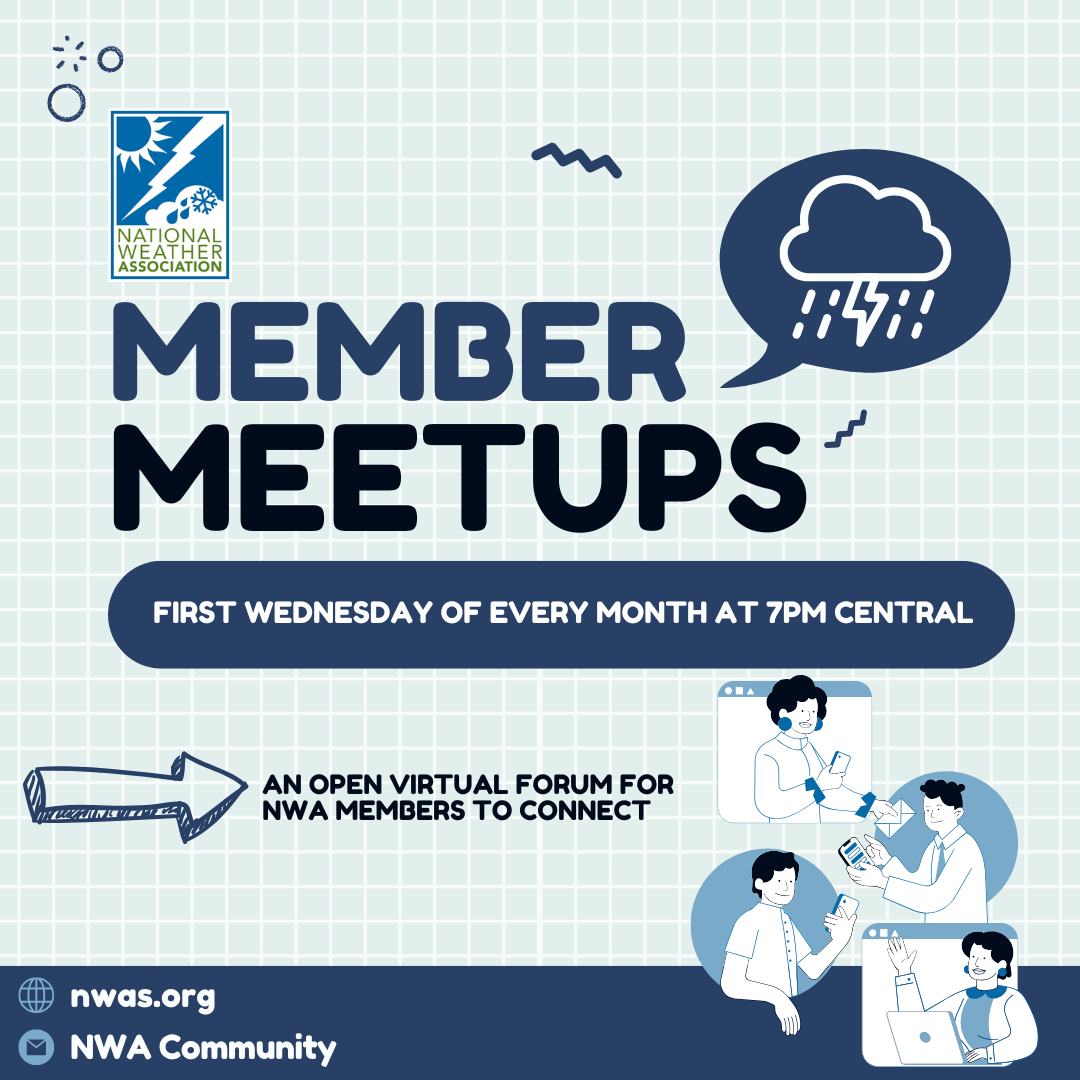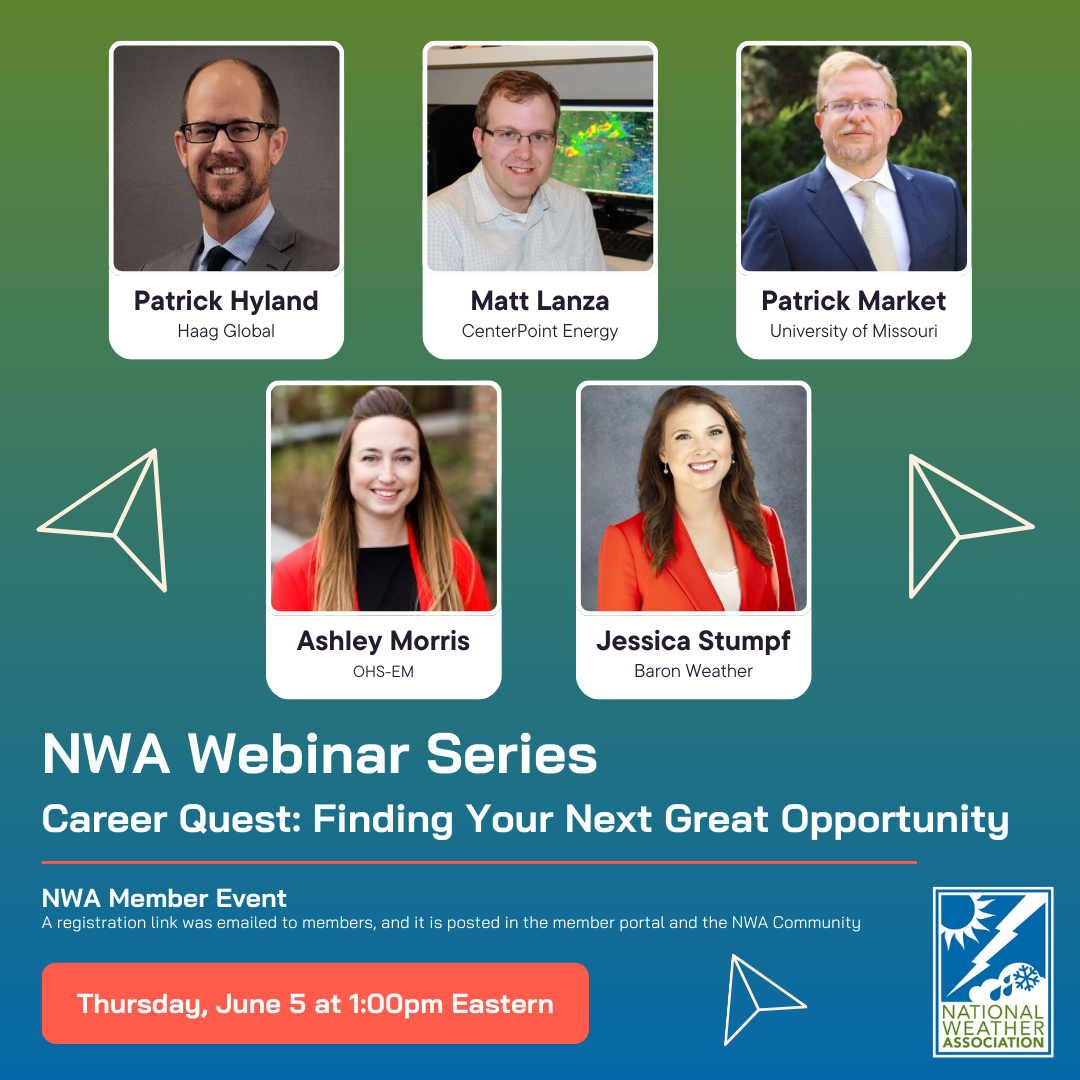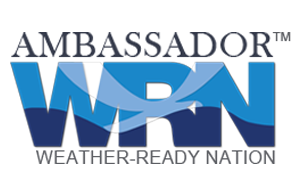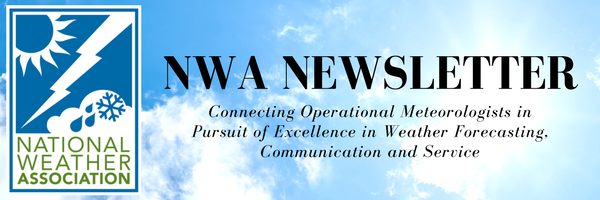 NWA January 2019 Newsletter
Issue 19 - 1 President's Message
NWA President Paul Schlatter
Pay it Forward
It’s been a year since I was elected, so hopefully you don’t mind a brief summary of who I am, especially since it directly ties in to how I chose the 2019 theme. Like many of you, I wanted to be a meteorologist since I was about 8 years old. My father is a retired Ph.D. meteorologist who worked at the National Center for Atmospheric Research (NCAR) and then NOAA in Boulder, Colorado, where I grew up. I was one lucky kid. My Dad has always been as much of a weather geek as I am, and we shared that passion throughout my school years. After graduating from the University of Oklahoma with a master's degree, I worked at the National Weather Service (NWS) Warning Decision Training Branch (WDTB, now Warning Decision Training Division, WDTD) in Norman, Oklahoma, starting in 2003. I specialized in dual-polarization radar and was the project manager and subject matter expert for the operations course in 2011-12. From there I moved my family to the Washington D.C. area to work at NWS and NOAA headquarters in a variety of roles, most of which did not involve much science. I was okay with that as I expanded my skillset and professional network immensely during those five years. In 2016 my dream job opened at the NWS office in Boulder, and since then I have been the Science and Operations Officer in the office I grew up following closely. The only place I have ever wanted to work is with the NWS, and now I am working in the office I’ve always wanted to work in. It’s cheesy but true: I am living the dream. “But Paul,” you may be thinking, “How does any of this relate to the NWA and this year’s theme?” My career path was shaped by (heck, it was only possible because of) a few people in my life who were and are always there for me, every step of the way. One person in particular, Liz Quoetone, asked me to join the NWA, and she happened to be my mentor during the earliest parts of my career. Liz, as have my other mentors, inspired the NWA 2019 theme: “Pay it Forward.” Why am I so passionate about this? It goes back to my first job at the WDTB, where Liz Queotone was in the right place and time to mentor me. Many of you knew Liz, she was the NWA president in 2012. She was someone who didn’t say much in meetings, but when she did everyone paid close attention because it was always the right thing to say or do. Many of you know that cancer took Liz’s life way too early in 2014. If Liz were still around today, she would ask us to think about who we should invite to join the NWA. I am sure you have someone in your life, whether at work or school, that you know would benefit greatly from joining our organization. You probably also have someone in mind that you could mentor, or that you wished was your mentor. Paying it forward means you are inspired to be the kind of person your mentor is, or was, to you. Every single one of us has unique talents and skills that can and should be shared with others. Every single one of us can be a mentor. It is my hope that in 2019 every one of you will serve as a mentor, find a mentor, or continue building those types of relationships. These things are the essence of "Pay It Forward." In 2019, the NWA Board of Directors and I, along with the NWA staff and the NWA Annual Meeting Program Committee, will think outside the box on how to Pay It Forward. One of the key areas of focus will be introducing unique and interactive sessions at the next Annual Meeting and adding more networking opportunities, not just for students but for all attendees. Another way we plan to Pay It Forward will be via a formal Mentoring Program within the NWA—stay tuned for details. I hope you are inspired like I am to Pay It Forward in 2019, and let me know if you have any great ideas on how you, or the NWA, can do this. 2019 Election Results Thank you to all candidates who ran for seats on the NWA Board of Directors, and all members who voted in the election. Congratulations to the following individuals who will begin their terms on January 1, 2019.
Pat Spoden continues as the Commissioner of Committees, which is a non-voting position.
One More Meteorologist Gets Seal to Wrap Up 2018 by Justin Chambers, Broadcast Meteorology Committee Public Relations Chair Hats off and salutations to meteorologist Bryan Schuerman! Originally from Lawrenceburg, Indiana, Bryan is a graduate of California University of Pennsylvania with a Bachelor of Science degree in science and technology, and Master of Education degrees in advanced studies in secondary education and teacher leadership. Prior to moving back home, Bryan was the Chief Meteorologist for WBOY-TV 12 News in Clarksburg, West Virginia, and a part time seventh and eighth grade general science teacher at Lincoln Middle School in West Virginia. “My favorite type of weather to cover, hands down, is severe weather - especially tornadoes,” says Schuerman. “The reason I wanted to become a meteorologist was the 1990 Cincinnati tornado outbreak when I was a kid. Ever since then, it has been a fascination.” With what little free time Bryan has, he likes to travel to Florida and Washington, D.C. to visit friends as well as spend time with his family. As for his favorite type of cloud, Bryan says it’s the cumulonimbus. “I love seeing those clouds form off in the distance. It is a sign that storms are coming and storms really energize me.”
New Publications in the Journal of Operational Meteorology
An article and a short contribution have been published in the NWA’s JOM since October 2018. JOM 2018-8 (Short Contribution): Atmospheric Rivers and National Weather Service Watches, Warnings, and Advisories Issued Over California 2007–2016, by Jason Cordeira, Molly M. Neureuter, and Liam D. Kelleher. Figure 6. (Right: From JOM 2018-8) Likelihood of at least one WWA at each Public Forecast Zone in CA on days with a landfalling AR at 38°N with a maximum daily intensity (a) ≥250 kg m–1s–1 and (b) ≥500 kg m–1s–1 during October–March and their respective differences from climatology in (c) and (d). Climatology is calculated based on random chance over the 10-year period.
JOM 2018-9 (Article): Understanding Emergency Manager Forecast Use in Severe Weather Events, by Sean Ernst, Daphne Ladue, and Alan Gerard.
Figure 2. (Left: From JOM 2018-9) EMs understand that certainty in the details of a potential weather impact increases with time and ask questions that seek greater detail as a potential impact draws closer to fill information gaps between forecast product issuances. Note that certainty in the details of a weather impact do not reach zero as the event occurs. Certainty is only achieved after details of impacts are verified, sometimes well after the event occurs (graphic not to scale).
The JOM publishes submissions in four categories: Article, Short Contribution, Images of Note and Commentary. The JOM is a peer-reviewed, all-electronic journal with an international scope, providing authors with the benefits of economical publication costs and rapid publication following acceptance. If you are interested in submitting a paper to the JOM, please go to the website for author information. Thank you to the JOM authors, reviewers and editors for continuing to make JOM a success! by Nate Johnson, Broadcast Committee Chair
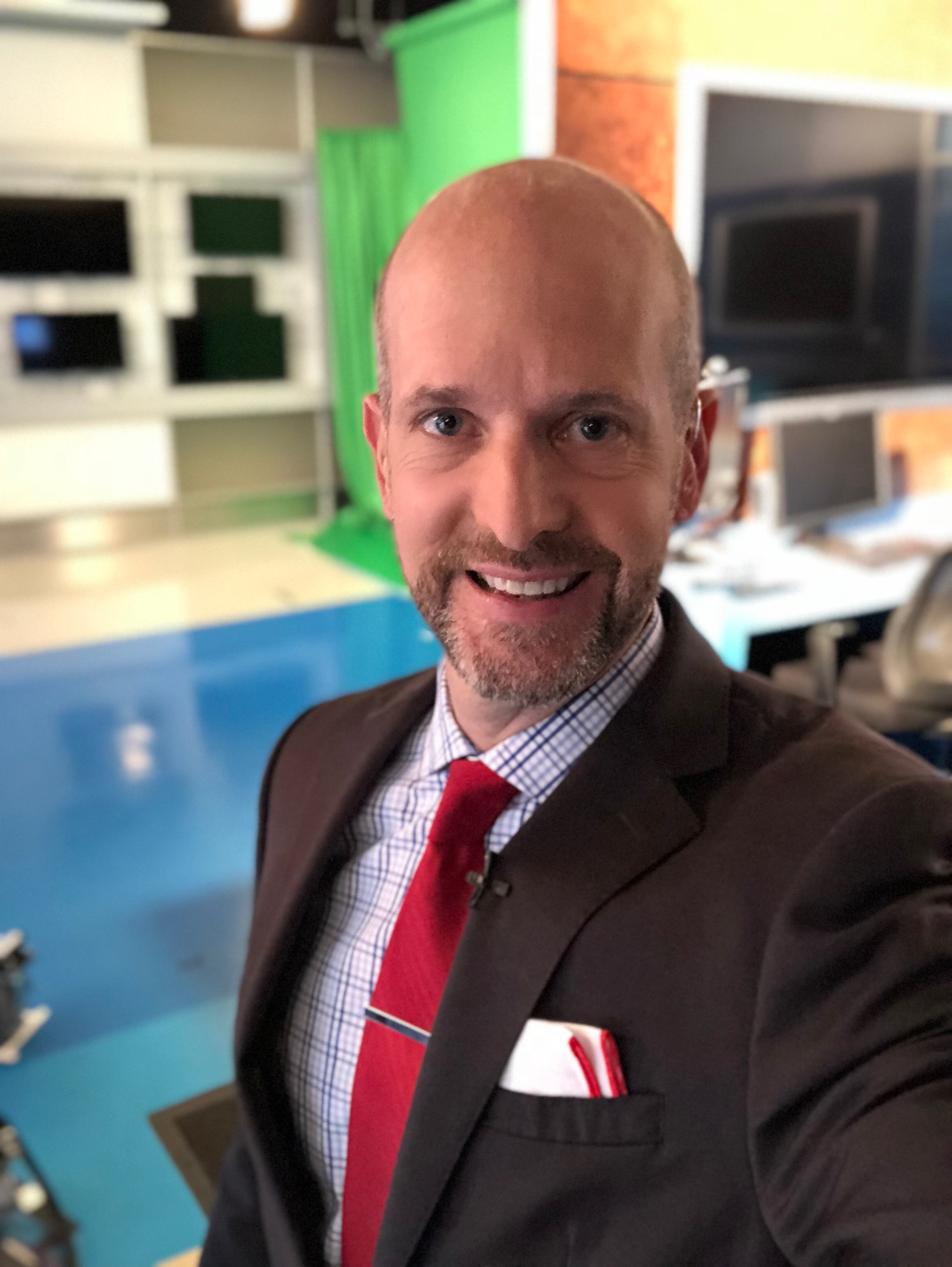 Brad Panovich is chief meteorologist at WCNC-TV in Charlotte, North Carolina, but you may know him better as @wxbrad. He’s one of a few meteorologists with a significant reach beyond their own local areas. But it’s not all about Twitter and Facebook. It’s been a busy year for Panovich and the Charlotte area with snow, the remnants of multiple hurricanes, and severe weather. One of those hurricanes spurred a charity project in the area, too. The Broadcast Committee had some questions for Brad about all of that. [Some of his answers have been lightly edited for length and clarity.] Brad Panovich is chief meteorologist at WCNC-TV in Charlotte, North Carolina, but you may know him better as @wxbrad. He’s one of a few meteorologists with a significant reach beyond their own local areas. But it’s not all about Twitter and Facebook. It’s been a busy year for Panovich and the Charlotte area with snow, the remnants of multiple hurricanes, and severe weather. One of those hurricanes spurred a charity project in the area, too. The Broadcast Committee had some questions for Brad about all of that. [Some of his answers have been lightly edited for length and clarity.]
Q. How did your career bring you to NBC Charlotte? Q. You are one of only a handful of local meteorologists with a truly national following. How do you juggle both responsibilities? It's hard sometimes. I forget how many people follow me outside of my TV market. Until I start getting questions about severe weather, hurricanes, and snowstorms from all over the place. The biggest thing I do is try to keep in this mind when I do online updates and posts, especially my VLOGs. The other thing is I usually stay in my market for day-to-day weather, but for high-impact events I'll post updates just because I know people are looking for my thoughts. As a weather geek, it's not hard to post about these events; I'm naturally looking and thinking about them anyways. Q. We don’t normally think of Charlotte as a hurricane-prone city, but it’s had its fair share. What are some notable storms from the Queen City’s history? The big one here was Hugo in 1989. It struck Charlotte still as a Category 1 hurricane with 80 mph winds. The city’s heavy tree canopy was devastated, and power was out for weeks. Everyone here measures and compares all storms to Hugo. Other big storms here have been Matthew, Frances, Fay, Florence, and Michael. All caused flooding, wind damage, and tornadoes. While everyone thinks we are going to see a Hugo-type event, most of the time we have a huge inland flood threat here and tornado risk. Q. This year brought two hurricanes coming from different directions and with different threats. How did you handle those? Florence was a slow-motion storm. We started talking about it almost 10 days out which is rare for any storm. Then it took three days to move through. The combination of the long lead-up and slow movement was exhausting. Our main job was to make sure people understood there were two events: the coastal event with wind and surge, and then the slow three-day freshwater flood event. Michael was so fast, and while we knew it wasn’t [going to be like] Florence, there was going to be some flooding because the rains from Florence had saturated everything. Michael ended up being a big wind event for us. We had many more trees and power lines down, but the good news was it happened over a 12-hour window and then it was done. Q. Tell us about #ImaFanovich. So #ImaFanovich was started by some moms around Charlotte and my wife online during Florence. I had no idea it was going on due to the long days and Florence coverage. Basically, people wanted to give back to me for working so hard, but then it transformed into a relief effort for the hurricane. Shirts were created to show appreciation, but all the money went to hurricane relief. It kind blew up and ended up raising more than $37,000 for three charities. I was shocked and amazed when I found out about it. Truly made me proud to work and live in the Carolinas. The people are so good to me and each other. Q. What does the future of broadcast meteorology look like? Where will we be in 20 years? I'm not sure it will be called broadcasting anymore, that’s for sure. I think the model will be well suited for meteorologists. We already live by the 24/7/365 model of covering weather. I think our distribution model will change though. We will be providing content on different platforms and more frequently than just appointment TV times. The major thing that will change is the markets. We always defined our coverage areas from the distance our signal of a TV transmitter. In the future, we won't have those limitations, though being too big could be bad. I think serving a local audience with hyper-local and hyper-personal approach is going to serve us well. People still like hearing from people and not machines or just models. We need to remember as our data becomes better and more automated, the personal touch is still the key part of our jobs.
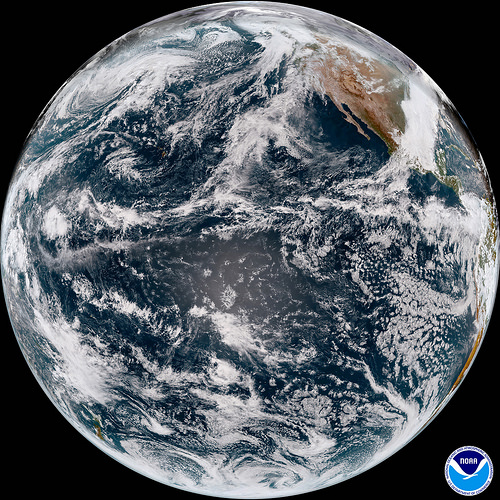 The GOES-17 transition to GOES West, which had been scheduled for December 10, has been delayed to the week of January 7, 2019. GOES-15 will remain the official GOES-West until that transition. In late November, the GOES-17 Advanced Baseline Imager (ABI) experienced an error that resulted in degraded infrared imagery. Normal ABI operation has since been restored and there has been no subsequent degraded imagery. NESDIS engineers are testing a permanent software correction that should conclude in January 2019. In the meantime, the previously scheduled ABI calibration activities have resumed and all preparatory activities leading up to the transition are expected to conclude in January, after which the GOES-17 operational declaration will be made. GOES-17 and GOES-15 will operate in tandem from their respective locations of 137.2 and 128 degrees west for at least six months to assess the performance of GOES-17. Please refer to the GOES-17 web page for the latest updates. Helping Others Win, Too: Mentorship in the Meteorological Community As individuals passionate about meteorology1 , we have long been interested in fostering a love for weather in and an application of weather concepts by people of all ages. Our endeavors derive from two key principles: a shared philosophy that learning trumps education, and a shared belief in the power of mentorship. We believe learning and education are inherently different concepts. Philosophically, learning is an action state, a process by which an individual is self-motivated and seeks out knowledge. Education, in contrast, is a passive process by which the individual is in essence spoon-fed information by someone else. Thus, we ask not “how can we better educate students,” but rather, “how can we better enable students to meet their own learning needs.” It is here where mentorship steps into the limelight. A mentor, as defined by the Merriam-Webster Dictionary, is “someone who teaches or gives help and advice to a less experienced and often younger person.” We believe this conceptualization encapsulates a far broader, more meaningful scope. In every interpersonal interaction that occurs, there exists the potential to teach another person something, even if just in passing for a few moments. We learn and, in turn, teach (without ever knowing it) in adapting to the myriad of situations that each of us faces daily. Mentoring, then, is something everyone does, perhaps not strictly by the formal dictionary definition, but in a broader sense. Mentoring relies on a person wishing to share something (e.g., knowledge, skills, experiences). The meteorological community is fortunate to have a plethora of people willing to undertake mentorship for the benefit of future generations. This can be seen in past generations of meteorologists guiding those who are now established, or becoming established, in the field, and in the current mix of other weather-oriented professionals (e.g., some social scientists, emergency managers) wishing to help those on the rise in their own areas of the weather sphere. This clearly demonstrates the “paying it forward” principle.
We are both products of this evolving process. Each of us has mentored scores of people in weather, social science, writing, teamwork, and numerous other skills, and we both have been mentored by multiple people. Mike has had some two dozen documented mentors and Matt has already amassed more than a dozen. Yes, there’s no reason to be limited to one or two mentors! As a tutor, Mike helps students LEARN math, writing, and test-taking strategies (he doesn’t educate), and to figure out what they want to do with the rest of their lives. Matt, meanwhile, is enthusiastic in mentoring numerous students with various learning-affecting and other individual differences (e.g., autism, dyslexia). We’ll talk more about these efforts in the two articles following this one early next year. It would be easy to classify our own mentors as weather-focused, but nothing is further from the truth. Dr. William Bonner (a meteorologist and former NWS Director) taught Mike about writing while Herb Lieb (a Public Affairs Officer with NWS) counseled him in teamwork, the mass media, communication, and much more. Mike’s wife (Barbara Levine) guided him in conveying effective teaching strategies. Matt’s mentors include Brian LaMarre, Dan Noah, and Barry Damiano (NWS MIC, WCM, and former NOAA Hurricane Hunter meteorologist, respectively), who, in guiding his early steps into meteorology as a high school student, modeled the highest standards of professionalism and taught him the importance of professional integrity; Mike Mogil (obviously), whose guidance over the years has touched on personal, life-oriented topics (e.g., good interpersonal communication) as much as professional; and Dr. Greg Blumberg, a research meteorologist who influenced Matt’s ethical beliefs while sharpening his analytical thinking and science writing skills. Ken Carey guided both of us in mentoring, team-building, and much more.
Mentorship is a mutual journey, a near-symbiotic relationship, experienced by both teacher and student. The actions of one individual affect the other, possibly quite directly. What’s more, mentorship is a mindset as much as it is active action. This is because effective mentors (people dedicated to guiding and facilitating learning for others, not people who passively teach), in our view, regularly introspect on their own human imperfections and make an effort to connect with the mentee on his or her own unique level. Self-reflection is crucial; without it, the mentor does not find the essential aspects of themselves that are so important to mentoring, those key qualities and ideals that are "invisible to the eye ("The Little Prince" by Saint Saint-Exupéry, 1943). It is by this process the mentor finds the qualities he or she wishes to model to others. In closing, we stress that mentors need to recognize that attitudes and beliefs are caught, not taught. The greatest lessons mentors convey come through their own actions and life-long experiences, as well as leading by example. Effective mentors are cognizant of their actions during professional and personal hours alike, striving to model appropriate behaviors to their mentees. Ideally, mentors ground themselves in humility and selflessness and strive to remember that what they are doing in mentorship is bigger than themselves. In the words of the late Fred Rogers, what matters is “not winning for ourselves, but helping others win, too, even if it means slowing down and changing our course now and then.” 1 Matt Bolton is a current student member, and H. Michael Mogil a former member, of the NWA’s Professional Development Committee (PDC).
Return to Menu |
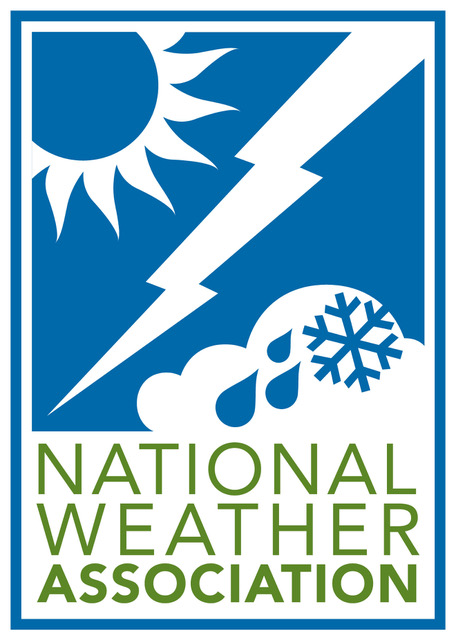
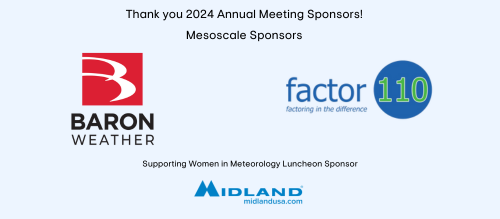
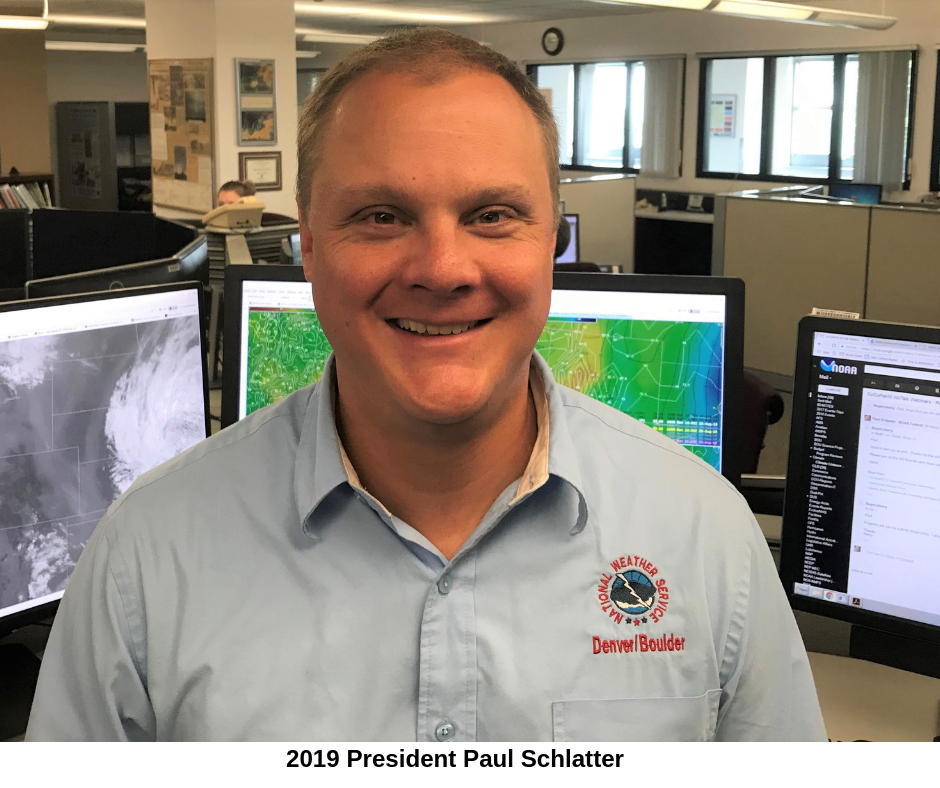 Happy New Year National Weather Association! I am excited to be your president in 2019, and look forward to working for you to make 2019 another good year for the NWA. In my first installment of the President’s Message, I want to highlight the theme for the NWA in 2019, which will carry us through the year and be reflected at the 2019 Annual Meeting in Huntsville, Alabama, September 7-12. But first, I want to recognize our outgoing president, Alan Sealls. He’ll be the first to admit that accomplishments in 2018 were the result of a team effort. Nevertheless, Alan did a fantastic job leading the way on several important initiatives. The NWA has a new set of by-laws in place, which are a benefit to all of us because they help the NWA reduce risk, maximize resources, and operate much more effectively like a business. His theme from last year, “Diversity in People, Models, and Methods,” resulted in fantastic sessions and networking opportunities at the annual meeting in St. Louis.
Happy New Year National Weather Association! I am excited to be your president in 2019, and look forward to working for you to make 2019 another good year for the NWA. In my first installment of the President’s Message, I want to highlight the theme for the NWA in 2019, which will carry us through the year and be reflected at the 2019 Annual Meeting in Huntsville, Alabama, September 7-12. But first, I want to recognize our outgoing president, Alan Sealls. He’ll be the first to admit that accomplishments in 2018 were the result of a team effort. Nevertheless, Alan did a fantastic job leading the way on several important initiatives. The NWA has a new set of by-laws in place, which are a benefit to all of us because they help the NWA reduce risk, maximize resources, and operate much more effectively like a business. His theme from last year, “Diversity in People, Models, and Methods,” resulted in fantastic sessions and networking opportunities at the annual meeting in St. Louis. 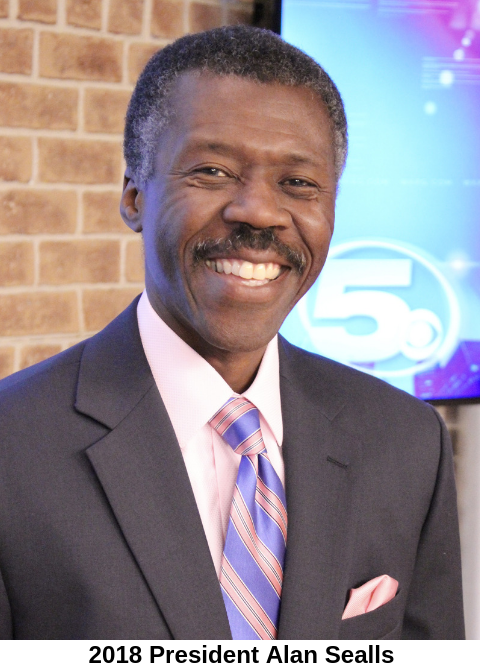
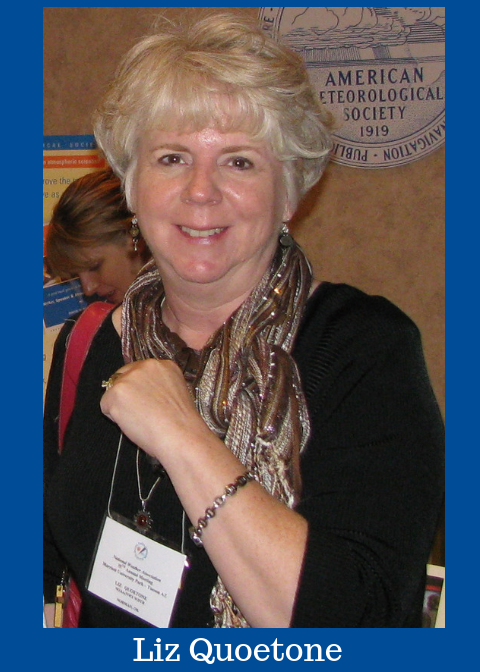 Her opinions carried enormous weight because she was universally respected, extremely wise, humble, and could communicate with anyone. Most of all it was obvious that she deeply cared for people, especially those she worked with. She always had the right advice for me when I was presented with a challenging problem. For example, when I made a mistake about a year into my career, I thought I would be fired—I was 27 years old and in my very first job. Instead, she delicately explained to me how to make it right and how to avoid ever doing it again. In 2006, Liz encouraged me to join the NWA noting how passionate I was about operational meteorology. Because it was Liz, my mentor, that suggestion carried a ton of weight, so I joined that year. It was Liz who took a chance on me by getting me on the 2011 ballot for the NWA Council (now called the Board of Directors). To this day, in the back of my head when faced with a challenging situation, I think to myself “What would Liz do?”
Her opinions carried enormous weight because she was universally respected, extremely wise, humble, and could communicate with anyone. Most of all it was obvious that she deeply cared for people, especially those she worked with. She always had the right advice for me when I was presented with a challenging problem. For example, when I made a mistake about a year into my career, I thought I would be fired—I was 27 years old and in my very first job. Instead, she delicately explained to me how to make it right and how to avoid ever doing it again. In 2006, Liz encouraged me to join the NWA noting how passionate I was about operational meteorology. Because it was Liz, my mentor, that suggestion carried a ton of weight, so I joined that year. It was Liz who took a chance on me by getting me on the 2011 ballot for the NWA Council (now called the Board of Directors). To this day, in the back of my head when faced with a challenging situation, I think to myself “What would Liz do?”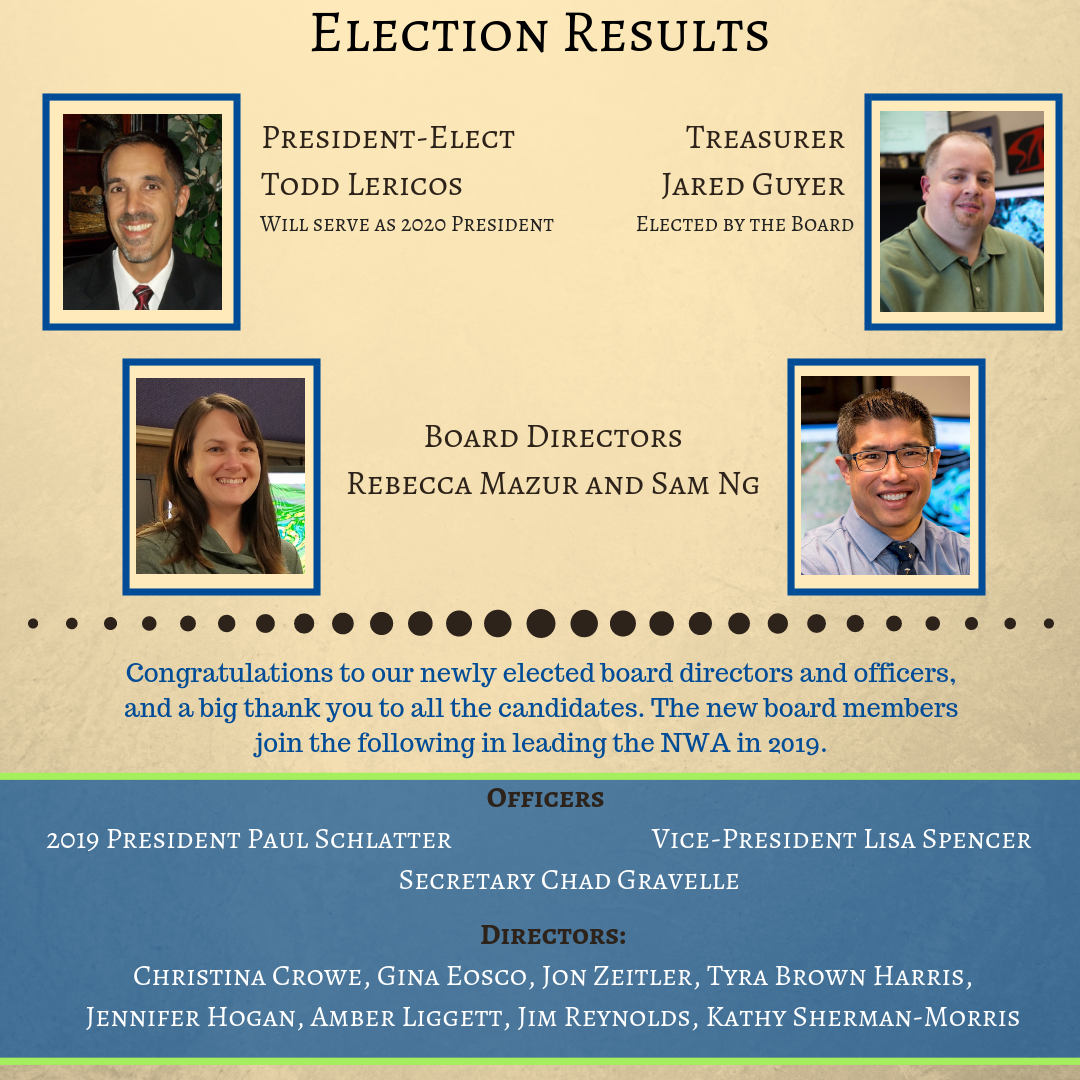



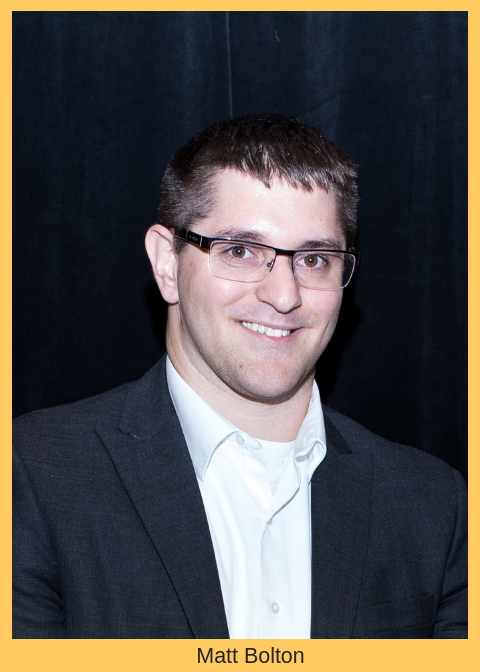

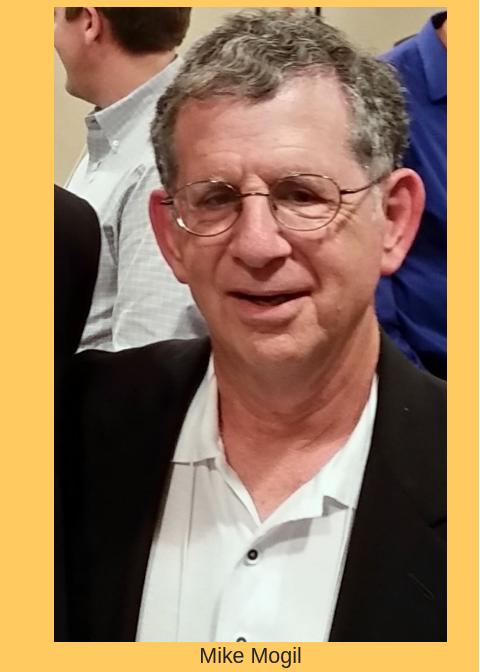 In short, mentors are everywhere and can be in many arenas simultaneously. Here, for example, we are mentoring about mentoring, not about meteorology. Most readers have probably done various amounts of mentoring, and have been in many mentee roles themselves. Hopefully, after reading this article series, you will be a stronger, more active mentor than you may be now.
In short, mentors are everywhere and can be in many arenas simultaneously. Here, for example, we are mentoring about mentoring, not about meteorology. Most readers have probably done various amounts of mentoring, and have been in many mentee roles themselves. Hopefully, after reading this article series, you will be a stronger, more active mentor than you may be now.